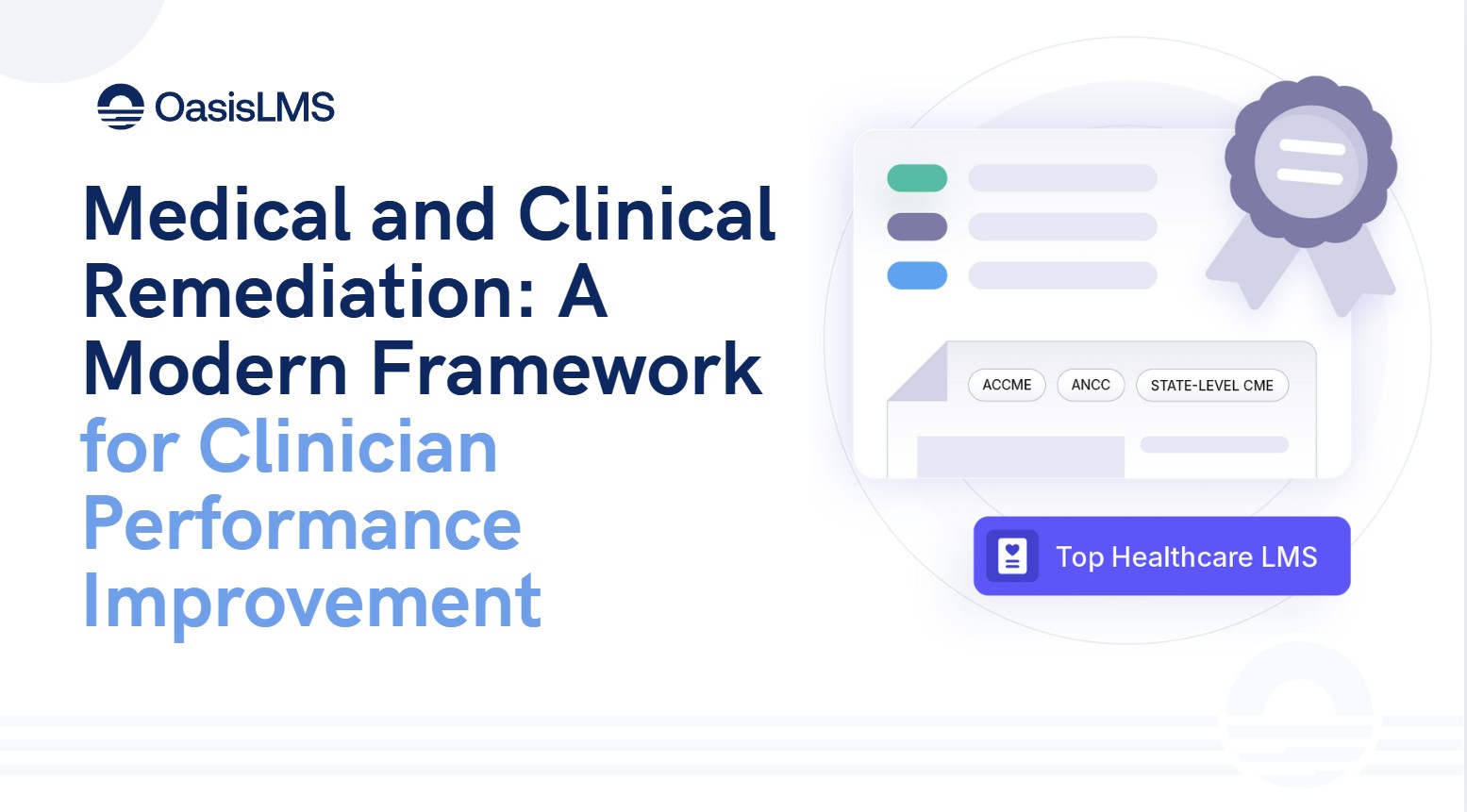
In today’s healthcare environment, maintaining clinical competence isn’t just an individual responsibility, it is a system-level priority. Medical and clinical remediation programs play a crucial role in helping healthcare professionals bridge performance gaps, meet regulatory expectations, and ultimately deliver safer, higher-quality care.
Historically, remediation was viewed as punitive, a last resort after repeated performance issues. But modern healthcare organizations are reframing remediation as an opportunity for professional growth. Supported by continuing medical education (CME) and performance improvement frameworks, structured remediation helps clinicians regain confidence, rebuild trust, and return to practice stronger than before.
This article explores what medical and clinical remediation really mean, how to design effective programs, and how technology platforms like OasisLMS can help hospitals and CME departments manage the process with structure, documentation, and empathy.
The terms medical remediation and clinical remediation are often used interchangeably but they address different layers of performance improvement.
For example, a clinician who struggles with updated antibiotic stewardship guidelines might benefit from medical remediation, while one facing communication challenges in multidisciplinary teams may require a clinical remediation plan with coaching and feedback.
In practice, most remediation programs combine both elements, knowledge refreshers and real-world skill rebuilding, to achieve sustainable performance improvement.
Remediation can be triggered by many types of performance data, from informal feedback to formal assessments. Common scenarios include:
Importantly, remediation should be proactive, not punitive. When organizations treat remediation as a developmental process, not a disciplinary one, they foster a culture of safety, reflection, and life long learning.
A structured remediation plan should balance accountability with support. The most successful programs follow a systematic approach that includes:
Use validated assessment tools, peer reviews, or case simulations to identify precise areas for improvement, not just general underperformance. Many institutions align these with ACGME or ACCME competency domains.
Translate findings into specific learning objectives and behavioral outcomes. Example: “Demonstrate accurate documentation of post-procedure complications in 5 consecutive cases.”
Blend CME courses, mentoring, self-study, and supervised practice to fit the clinician’s context and learning style.
Assign a remediation mentor or medical educator to provide guidance, monitor progress, and maintain psychological safety.
Track every step of the process, from learning assignments to outcome reviews. Documentation ensures transparency, protects both clinician and institution, and demonstrates compliance with regulatory bodies.
Even with good intentions, implementing remediation can be complex. Common barriers include:
Without structure, remediation risks becoming reactive or inconsistent. That’s why more organizations are turning to healthcare learning management systems (LMS) to streamline the process and ensure fairness and consistency.
When you compare modern healthcare LMS platforms, such as OasisLMS, you will see how they are transforming the management of remediation programs. Instead of juggling paper checklists or spreadsheets, educators can use technology to make remediation more structured, transparent, and data-driven.
Here’s how OasisLMS supports healthcare remediation workflows:
Individualized Learning Plans
Administrators can assign personalized modules tied to competency framework, ensuring that each clinician’s learning path targets the exact skill or knowledge gap identified.
Competency-Based Tracking
Progress can be tracked against specific outcomes, such as improvement in assessment scores or successful case reviews.
Secure Documentation and Audit Trails
All remediation steps, from assigned activities to mentor feedback, are automatically logged. This provides defensible, time-stamped records for credentialing and compliance.
Integration with CME Credit Systems
OasisLMS integrates with CME and MOC credit systems, allowing organizations to connect remediation activities with accredited learning outcomes.
Analytics and Reporting
Program leaders can measure completion rates, competency gains, and performance trends, enabling continuous improvement across teams or departments.
By digitizing the process, OasisLMS helps institutions balance accountability with empathy, ensuring clinicians feel supported, not punished, as they rebuild professional confidence.
Creating a culture where remediation is seen as professional development, not failure, is essential. The most effective organizations share these best practices:
By treating remediation as a structured learning journey, organizations cultivate trust, competence, and continuous improvement.
Medical and clinical remediation are no longer niche activities reserved for struggling clinicians, they are essential components of modern healthcare quality and professional development.
When supported by a strong educational framework and the right technology, remediation becomes a catalyst for better patient outcomes and stronger clinician engagement.
Whether your organization is refining its CME programs or designing formal performance-improvement pathways, OasisLMS provides the tools to deliver structured, trackable, and compassionate remediation experiences.
Explore how OasisLMS can support your medical and clinical remediation programs, from customized learning paths to comprehensive progress documentation.
Book a demo today
Whether managing CME for physicians or supporting member growth, Oasis LMS helps deliver high-impact education efficiently and at scale.
